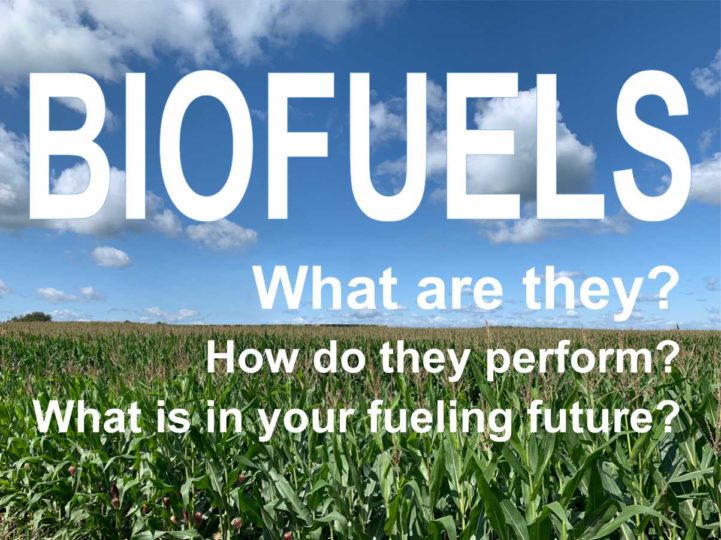
What are biofuels?
Biofuels are fuels derived from biological materials. The use of biological material (biomass) as an energy source is not new. After all, wood is a biological material and campfires go back tens of thousands of years. The difference between biofuels and fossil fuels is that fossil fuels come from plants and organisms that died millions of years ago and were subjected to high temperatures and pressures eventually forming coal, oil, or natural gas deposits. Biofuels, on the other hand, are produced from biological material that has been living recently.
What are the different biofuels available today?
All biofuels broadly used today are blended with petroleum fuels. Blends are labeled by the % of biofuel blended in. For example, an E10 blend is 10% ethanol to 90% traditional gasoline. On the diesel and home heating side, a B-20 would be 20% biofuel and 80% petroleum fuel.
- Ethanol: Most of our nation’s gasoline supply is blended with up to 10% ethanol. Although engines can run on 98% ethanol, they must be modified or fuel economy will be negatively affected. On the plus side, Ethanol has higher octane levels than gasoline, which provides increased power and performance. Fun fact: Indianapolis 500 drivers often fuel their race cars with E-98 because of its high octane.
- Biodiesel is an alternative fuel to diesel, which cannot be used on its own in traditional internal combustion engines but can be blended with traditional petroleum fuel.
- Bioheat is Biodiesel formulated as a heating oil replacement.

Are biofuels better for the environment?
The carbon dioxide released by a vehicle or burner when biofuel is burned is offset by the carbon dioxide captured when the feedstock crops are grown to produce the fuel feedstocks. This differs from gasoline and diesel, which are fossil fuels refined from petroleum extracted from the earth with no emissions offset.
On a life cycle analysis basis, greenhouse gas emissions are reduced on average by 34% with corn-based ethanol produced from dry mills, and range between 88% and 108% if cellulosic feedstocks (wood, switchgrass) are used, compared with gasoline and diesel production and use. Using these renewable resources is not only cleaner and more sustainable, their production generates approximately $16.8 billion dollars for the U.S. economy as well as creating and supporting over 50,000 jobs.
How does Bioheat compare to natural gas?
Bioheat is cleaner than natural gas. In a 20-year atmospheric life cycle analysis conducted by Brookhaven National Laboratories, emissions of greenhouse gases from Bioheat blends as low as 1.8% have been proven to be lower than those from natural gas. In addition, methane leaks from natural gas production are a HUGE and invisible contributor to greenhouse gasses, making it far “dirtier” from a life cycle perspective than bioheat.
How will my equipment run on Bioheat?
The good news is that home heating equipment typically runs better with bio blends than with 100% petroleum fuels. In a 2018 study Brookhaven National Laboratory study it was found that blends up to B-20 and beyond do not require changes in equipment or settings to burn efficiently and safely.
Is there biofuel currently blended into my home heating oil?
Yes! All fuel dealers in New York have been delivering Bioheat for the past few years. The current supply is already blended with up to 2% biodiesel before it gets distributed to fuel dealers. Our new Governor is expected to sign legislation that would move that threshold up to a 5% biofuel blend, or a B-5 blend, in 2022.
Does Bioheat cost more?
No. In fact, Bioheat can save you money because it helps your heating equipment run more efficiently, which extends the life of the equipment and can lead to fewer tune-ups.
What is the future of Bioheat?
It is here to stay. Biofuels offer a cleaner burn from a renewable resource (plants), resources which themselves help capture the carbon and greenhouse gasses we need to reduce. Our industry is committed to seeking out the most efficient and cleanest burning fuels possible. In the past, we moved away from sulphur and now deliver only ultra-low suphur fuels. In the future, it is expected that biofuels will continuously improve. Currently, many of the feedstocks used for biofuels are also food sources for humans and/or livestock, but a number of companies are moving forward to develop and market advanced second-generation biofuels made from non-food feedstocks, such as municipal waste, algae, perennial grasses, and wood chips. The possibilities are exciting as we find better answers to our energy needs!
